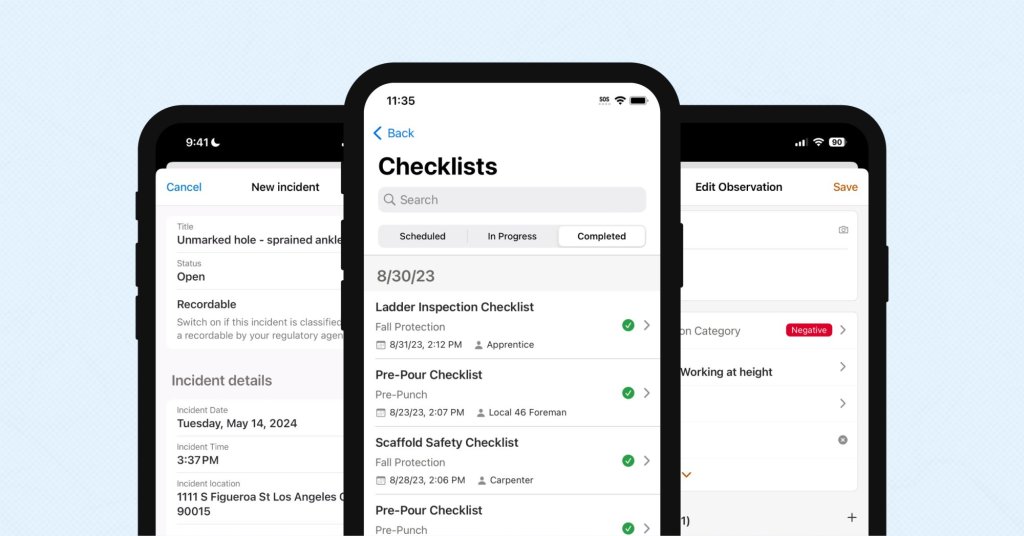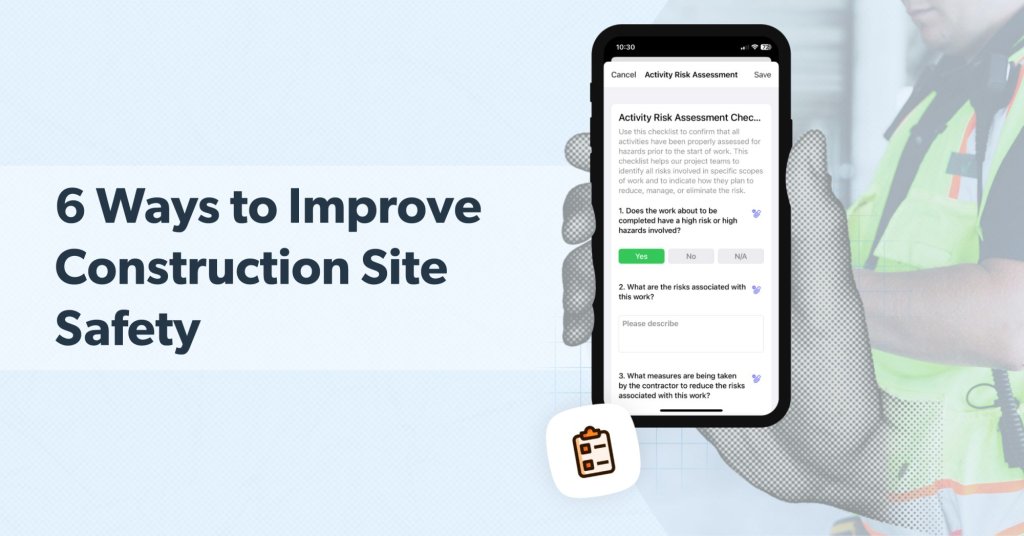From falls to electrical hazards, construction sites are full of risks. While some hazards are unavoidable, others can be resolved or eliminated with good construction site safety management.
Learn about the top 10 most common risks and discover ways to improve construction site safety on your projects.
The top 10 safety risks in construction
The Occupational Safety and Health Association (OSHA) keeps a record of all the safety citations issued to construction companies throughout the year. According to OSHA, between October 2022 and September 2023, the top ten most frequently cited hazards in construction were:
Duty to have fall protection - The workplace did not provide proper fall protection equipment for employees working from lifts, platforms, and other heights.
Ladders - The condition of ladders provided by the employer did not meet safety standards, or workers used ladders in an unsafe manner.
General requirements - The employer violated general OSHA requirements to ensure a safe work environment for employees.
Training requirements - Workers did not receive proper training for general safety or specific tasks.
Eye and face protection - Workers did not wear sufficient eye and face protection when exposed to hazardous conditions and materials.
Head protection - Workers did not wear appropriate protective headwear for the work environment.
General safety and health provisions - The employer failed to make provisions to maintain a safe and sanitary work environment.
Abatement verification - The employer failed to correct citations issued during a previous OSHA inspection.
Specific excavation requirements - The employer did not meet standards for safe excavation.
Aerial lift - Aerial lifts were not kept in safe working condition, or workers did not take the proper safety precautions when using them.
Receiving a citation isn’t just an indication of poor construction site safety management, it’s also a financial risk—failing to prevent the hazards listed above cost businesses a total of $117,820,959.
To protect your business from costly fines and keep your workers free from illness and injury, it’s important to establish best practices.
How to improve your construction site safety
There are many ways to improve construction site safety. The following tips can be incorporated into your safety plan to mitigate risks, reduce common hazards, and help your business avoid OSHA citations.
1. Hold toolbox talks
The first step towards improved construction site safety is making sure your employees can recognize the immediate hazards around them and understand how to safely resolve or avoid them. One of the easiest ways to offer consistent (and relevant) safety training is by holding regular toolbox talks. These brief meetings are typically conducted onsite before the start of the workday and are designed to inform workers of the specific hazards and risks of injury associated with their current tasks.
Empower your foremen and superintendents with a mobile library of toolbox talk topics—and the ability to schedule and record attendance digitally with a toolbox talk app—so they can easily provide timely reminders about site safety procedures. On a busy jobsite, a quick toolbox talk can make the difference between a safe workday and an incident.
2. Standardize procedures with digital safety checklists
Digital safety and quality checklists ensure workers follow necessary safety measures without constant oversight.
Standardized checklists take the guesswork out of proper procedures by providing workers with a step-by-step guide to inspections, site preparation, and other safety-related tasks. They’ll have an itemized list to reference instead of having to rely on memory and, once the checklist is completed, they can submit it to the office alongside the day’s daily report to document compliance.
While pen and paper methods can work to improve site safety, using digital checklists streamlines communication and allows completed checklists to be submitted in real time, so project managers and other supervisors can address any issues before they lead to incidents or delays.
With comprehensive construction checklist software, you’ll also get access to a library of premade construction checklist templates that can be easily customized for your processes.
3. Implement a formal construction site safety training program
Toolbox talks and checklists are an essential part of construction site safety, but they aren’t a replacement for formal education. As an employer, it’s your responsibility to make sure workers receive adequate training before they operate any tools or equipment or are assigned a new kind of task.
Make sure you have a formal program established for new employees and workers who are taking on additional roles or responsibilities. Additionally, all employees may occasionally need updated education on a periodic basis, especially as rules and standards may change.
Formal education should cover not just industry standards, but should also address your business’s safety plan and provide guidelines for what employees should do and who they should contact if a concern arises.
4. Report hazards immediately
Even with careful planning and preparation, accidents happen. For example, objects may fall, liquids may spill, or materials may arrive damaged. Likewise, weather or the environment may cause a hazard that’s out of workers’ control.
When this happens, you need a way for employees to quickly document hazards and share the details with the appropriate personnel. When a hazard is reported immediately, there is less of a chance it will lead to an incident.
Digital observation reporting tools help workers capture the details of a hazard onsite and alert the right stakeholders in real time. They can attach photos and videos for maximum clarity and track the resolution of any issues with automated notifications.
5. Digitally document incidents
In the unfortunate event of an incident, it’s important to document the details, including contributing factors. Not only may your business be required to record and even submit this information to OSHA, you can also use incident reports to help identify deficiencies in your safety plan and make impactful changes.
With digital incident capture, your teams can more quickly and comprehensively record the details of an illness or injury and attach photos or witness statements. You can keep incident documentation more secure, organized, and easily accessible.
6. Make continuous improvements
If you’re closely documenting safety on the construction site, you’ll have plenty of data to review. Take the time to periodically analyze the effectiveness of your safety strategies to determine any steps you need to take for further improvement.
You should most importantly identify common issues your team reported when completing checklists or submitting observations. Are there any factors that contribute to these issues that could be easily resolved? Then, you can assess compliance and see if your teams are struggling to follow safety procedures. Could you provide additional tools to make these processes easier?
Consider using safety analysis software to help you organize safety data across all your construction sites and make continuous improvements at the company level.
How Raken helps improve your construction site safety

Raken’s construction safety management software keeps all your critical safety tools in the same place. Prevent, identify, resolve, and report on safety issues to keep projects on track, using a single app.
Your field crews can use Raken to quickly document safety procedures onsite while your office team gains clear visibility from any location. We offer:
Managed checklists - Customize templates, assign checklists, and monitor completion
Observations - Report observations from the field, attach photos and videos, and track resolution progress
Incident reports - Capture the details of incidents and easily attach supporting documentation
Toolbox talks - Choose from over 100 topics, schedule talks, and digitally record attendance
Dashboards and insights - Monitor safety compliance and analyze trends at a glance
Our digital tools are designed for ease of use and come with award-winning customer support.
Improve Construction Site Safety with Raken
Schedule a personalized demo today.
